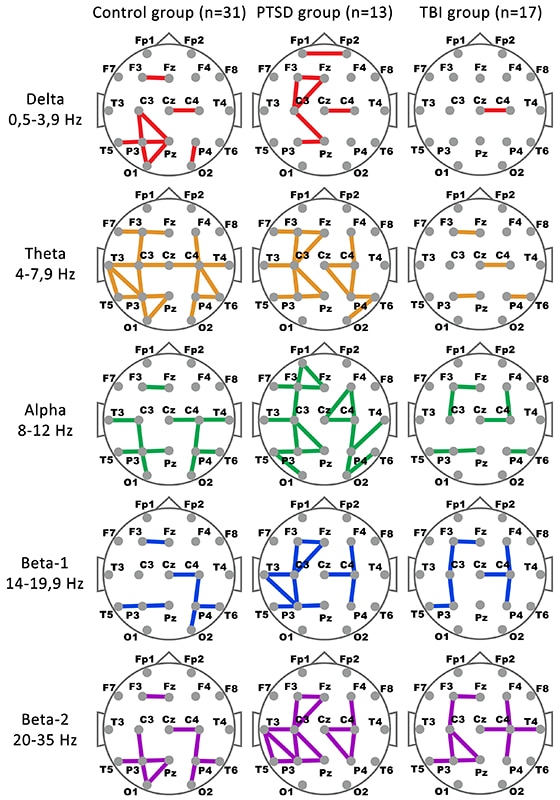Traumatic brain injury (TBI) and posttraumatic stress disorder (PTSD) are the most common impairments among military servicemembers who took part in armed conflicts. TBI and PTSD cause long-term cognitive impairments and respectively alterations in information processing and decision making (1,2). Choice reaction (CR) task is the simplest way to model decision making in the study. Participants. The study involved 31 volunteers (male 18-28 y.o.) without health complaints or reported PTSD and TBI (control group); 13 volunteers (male, 20-54 y.o.), servicemembers of Armed Forces of Ukraine with combat-related PTSD, and 17 volunteers (male, 22-50 y.o.), combat-injured servicemembers of Armed Forces of Ukraine with mild TBI (mTBI). All participants were right-handed and took part in the study after providing informed consent consistent with the Declaration of Helsinki. Procedure and Methods. CR computer task with two types of visual stimuli was used to test participants. CR time (CRT) of responses was detected. EEG was recorded at sampling rate 500 Hz during whole testing procedure. 19 electrodes were placed according to the international 10-20 system. Localization of regions of brain activity was identified with neuroimaging LORETA software (3). To display differences between groups statistical non-parametric mapping was conducted in LORETA (4). Functional connectivity was assessed with EEG coherence between all possible coupled pairs of electrodes in delta (0,5-3,9 Hz), theta (4-7,9 Hz), alpha (8-12 Hz), beta-1 (14-19,9 Hz) and beta-2 (20-35 Hz). Significant level of coherence value was established equal or greater than 0,7 (5). Results. CRT of mTBI group was significantly longer compared to control group (471 [446; 579] ms vs. 410 [392; 430] ms (U=116; p=0,002)), while there was no difference between PTSD patients and control group (434 [405; 485] ms vs. 410 [392; 430] ms (U=135; p=0,087)). In control group there was revealed activation of the fronto-parieto-occipital and temporo-occipital regions as well as connectivity between respective regions (Table 1). PTSD group demonstrated activation of the right fronto-parieto-temporal regions and the right insula in comparison vs. zero. There was no statistically significant difference revealed in comparison with control group (p=0,493). In PTSD group coherences were revealed between following pairs of electrodes demostrated in (Table 1). mTBI group had statistically significantly greater activation of the left temporo-occipital regions, the left insula and posterior cingulate gyrus during CR task compared to control group (p=0,018; F(0,05)=0,574)) (Table 2). Revealed coherences between pairs of electrodes in mTBI patients also are shown in (Table 1). Conclusions. In general PTSD group demonstrated similarity to control group in brain activity and functional connectivity that provided efficient CR, while mTBI group had slower CR, strong left lateralized brain activity and altered weak functional connectivity.
Physiology 2019 (Aberdeen, UK) (2019) Proc Physiol Soc 43, PC224
Poster Communications: Brain activity during choice reaction task in military servicemembers with mild traumatic brain injury and posttraumatic stress disorder
V. Vozniuk1, N. Filimonova1, M. Makarchuk1, I. Zyma1, O. Horbunov2, V. Kalnysh3
1. Human and animal physiology, ESC Institute of Biology and Medicine of Taras Shevchenko National University of Kyiv, Kyiv, Ukraine. 2. Computer science and cybernetics, Taras Shevchenko National University of Kyiv, Kyiv, Ukraine. 3. Kundiiev Institute of Occupational Health of the NAMS of Ukraine, Kyiv, Ukraine.
View other abstracts by:
Figure 1. Functional connectivity in control (n=31), PTSD (n=13) and mTBI (n=17) groups estimated as EEG coherence between respective pairs of electrodes in delta (0,5-3,9 Hz), theta (4-7,9 Hz), alpha (8-12 Hz), beta-1 (14-19,9 Hz) and beta-2 (20-35 Hz) bands.
Table 1. mTBI (n=17) vs. Control group (n=31). There was revealed significant difference between mTBI and Control group in One-Tailed test mTBI>Control (p=0,018; F(0,05)=0,574) and Two-Tailed test mTBI<>Control (p=0,036; F(0,05)=0,627).
Where applicable, experiments conform with Society ethical requirements.


